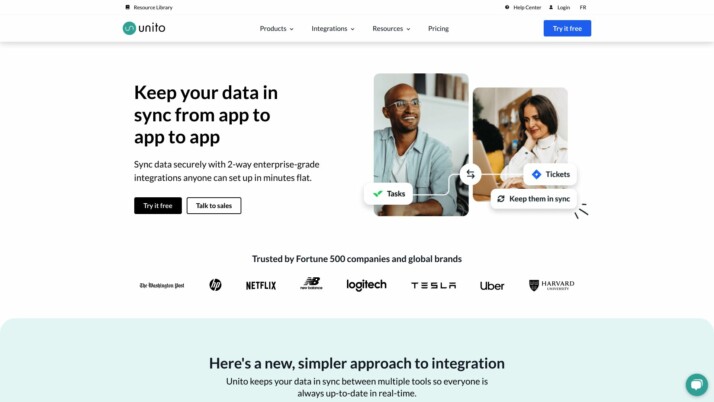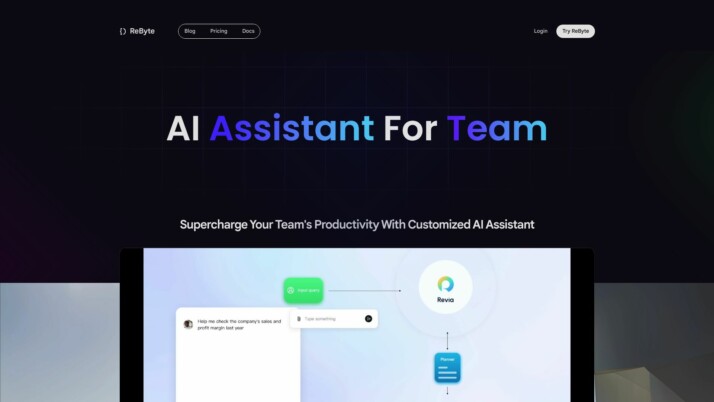Unito vs. Rebyte: AI Workflow Tools Compared
AI-driven workflow automation and integration solutions are reshaping how businesses operate, but choosing the right platform can be challenging. This comparison explores Unito’s powerful tool synchronization capabilities, Rebyte’s innovative AI agent creation platform, and SmythOS’s comprehensive AI development ecosystem. We’ll examine how each solution addresses key needs like workflow integration, AI agent development, and scalability. By analyzing their strengths and limitations, we aim to help you identify the best fit for your organization’s unique requirements in leveraging AI to boost productivity and streamline operations.
Unito Overview
Unito offers a powerful integration platform designed to streamline workflow management across diverse tools and teams. The Unito Sync Platform enables seamless connections between popular project management, collaboration, and development tools, eliminating data silos and enhancing productivity.
Unito’s core strength lies in its real-time two-way sync technology, which keeps information consistent across connected applications. This feature proves invaluable for teams using multiple tools, ensuring everyone stays updated regardless of their preferred platform. Unito supports deep field configuration, allowing users to customize syncing rules to match specific workflow requirements.


Unito’s core strength lies in its real-time two-way sync technology, which keeps information consistent across connected applications.
The platform’s no-code approach makes it accessible to users of all technical backgrounds. Its visual workflow designer empowers teams to create and visualize complex integrations without writing a single line of code. This democratization of workflow automation enables rapid implementation of cross-tool processes, significantly reducing the need for manual data transfer and duplicate work.
Unito prioritizes enterprise-level security, boasting SOC II Type 2 certification and HTTPS data encryption. The platform supports OAuth2 authentication, ensuring secure access to connected tools. While Unito excels in workflow automation and tool integration, it’s important to note that it doesn’t offer AI agent capabilities or advanced features like autonomous problem-solving or multimodal interactions.
The platform’s scalability makes it suitable for businesses of all sizes, from small teams to large enterprises. Unito’s ability to sync thousands of tasks demonstrates its capacity to handle bulk operations efficiently. However, users looking for AI-driven insights or advanced data analysis capabilities may find Unito’s offerings limited in this regard.
Rebyte Overview
Rebyte empowers users to create AI-powered applications without extensive coding skills. The platform’s visual agent builder enables the construction of complex AI agents using large language models, allowing for sophisticated backend logic development. Users can design fully customized interfaces for their agents without writing code, integrating private data sources seamlessly.


Rebyte’s serverless runtime facilitates production deployment and scaling of AI agents. The platform offers detailed observability into every step of an agent’s operation, providing users with valuable insights and control over their AI applications. This focus on transparency and monitoring aligns with the growing demand for explainable AI in various industries.
Rebyte empowers users to create AI-powered applications without extensive coding skills. The platform’s visual agent builder enables the construction of complex AI agents using large language models…
The open-source nature of Rebyte fosters collaboration and innovation within the developer community. By democratizing AI application development, Rebyte enables knowledge workers and teams to automate workflows and boost productivity through intuitive, no-code interfaces. This approach particularly benefits non-technical professionals and business users looking to leverage AI capabilities without deep technical expertise.
While Rebyte excels in visual building and no-code development, it lacks some advanced features found in enterprise-grade platforms. The absence of hosted agents for development and production environments may limit options for teams requiring robust, managed infrastructure. Additionally, Rebyte does not offer specific AI agent types or advanced features like autonomous agents or multi-agent collaboration, which could be drawbacks for users needing more sophisticated AI implementations.
Feature Comparison
Unito and Rebyte offer distinct approaches to workflow automation and AI agent development, with significant feature gaps between them. Unito excels in workflow integration and data synchronization across diverse tools, while Rebyte focuses on AI agent creation without extensive coding.
Unito’s core strength lies in its real-time two-way sync technology, which keeps information consistent across connected applications. This feature proves invaluable for teams using multiple tools, ensuring everyone stays updated regardless of their preferred platform. Unito also offers deep field configuration and customizable syncing rules to match specific workflow requirements. However, Unito lacks AI agent capabilities, autonomous problem-solving, and advanced features like multimodal interactions.
Rebyte, on the other hand, empowers users to create AI-powered applications using large language models through its visual agent builder. The platform enables the construction of complex AI agents with sophisticated backend logic, allowing users to design fully customized interfaces without writing code. Rebyte’s serverless runtime facilitates production deployment and scaling of AI agents. However, Rebyte does not offer specific AI agent types or advanced features like autonomous agents or multi-agent collaboration, which could be drawbacks for users needing more sophisticated AI implementations.
In terms of security, Unito prioritizes enterprise-level security with SOC II Type 2 certification and HTTPS data encryption, while Rebyte’s security features are not explicitly mentioned in the provided information. This gap in security information could be a concern for users dealing with sensitive data or requiring robust security measures.
Feature Comparison Table
| Unito | Rebyte | SmythOS | |
|---|---|---|---|
| CORE FEATURES | |||
| Autonomous Agents | ❌ | ❌ | ✅ |
| Multimodal | ❌ | ❌ | ✅ |
| Multi-Agent Collaboration | ✅ | ❌ | ✅ |
| Human-AI Interaction | ❌ | ✅ | ✅ |
| Agent Work Scheduler | ❌ | ✅ | ✅ |
| SECURITY | |||
| Constrained Alignment | ✅ | ❌ | ✅ |
| Data Encryption | ✅ | ❌ | ✅ |
| OAuth | ✅ | ❌ | ✅ |
| IP Control | ❌ | ❌ | ✅ |
| COMPONENTS | |||
| Foundation AIs | ❌ | ✅ | ✅ |
| Huggingface AIs | ❌ | ❌ | ✅ |
| Classifiers | ❌ | ❌ | ✅ |
| Logic | ❌ | ✅ | |
| Data Lakes | ❌ | ❌ | ✅ |
| DEPLOYMENT OPTIONS (EMBODIMENTS) | |||
| Deploy as Webhook | ❌ | ❌ | ✅ |
| Staging Domains | ❌ | ❌ | ✅ |
| Production Domains | ✅ | ❌ | ✅ |
| API Authentication (OAuth + Key) | ✅ | ❌ | ✅ |
| Deploy as Site Chat | ❌ | ✅ | ✅ |
| Deploy as Scheduled Agent | ❌ | ❌ | ✅ |
| Deploy as GPT | ❌ | ✅ | ✅ |
| DATA LAKE SUPPORT | |||
| Hosted Vector Database | ❌ | ✅ | ✅ |
| Sitemap Crawler | ❌ | ❌ | ✅ |
| YouTube Transcript Crawler | ❌ | ❌ | ✅ |
| URL Crawler | ❌ | ❌ | ✅ |
| PDF Support | ❌ | ✅ | ✅ |
| Word File Support | ❌ | ✅ | ✅ |
| TXT File Support | ❌ | ✅ | ✅ |
Best Alternative to Unito and Rebyte
SmythOS stands out as our superior alternative to Unito and Rebyte for AI agent development and workflow automation. SmythOS delivers a comprehensive platform that combines the strengths of both competitors while addressing their limitations.
Our drag-and-drop interface simplifies the creation of complex AI workflows, making advanced AI functionalities accessible to users with varying levels of technical expertise. This democratization of AI development allows a broader audience to innovate and implement effective AI solutions.
SmythOS excels in its extensive integration ecosystem, supporting a wide array of APIs, AI models, and tools. This flexibility ensures seamless incorporation into virtually any workflow or business process.
SmythOS excels in its extensive integration ecosystem, supporting a wide array of APIs, AI models, and tools. This flexibility ensures seamless incorporation into virtually any workflow or business process. Our pre-built API integrations and templates significantly reduce setup time, allowing users to focus on innovation rather than technical implementation.
Unlike Unito and Rebyte, SmythOS offers robust multi-agent orchestration capabilities. We enable the creation of collaborative AI agent systems that can tackle complex tasks with enhanced efficiency and scalability. This feature sets us apart in handling sophisticated AI implementations that our competitors cannot match.
Our platform also provides versatile deployment options, allowing AI solutions to be integrated across various platforms, including Google Vertex, Microsoft Copilot, and Amazon Web Services Bedrock. This flexibility, combined with our comprehensive security features and scalable architecture, makes SmythOS the ideal choice for businesses seeking a powerful, adaptable, and user-friendly AI agent development platform.
Conclusion
Unito and Rebyte offer distinct approaches to workflow automation and AI development, each with its own strengths and limitations. Unito excels in integrating diverse tools and synchronizing data across platforms, making it ideal for teams using multiple applications. Rebyte, on the other hand, focuses on enabling users to create AI-powered applications without extensive coding skills.
While both platforms have their merits, SmythOS emerges as the superior choice, offering a comprehensive solution that combines the best of both worlds and more. Our platform provides a powerful drag-and-drop interface for creating complex AI workflows, extensive API integrations, and support for a wide range of AI models. This versatility allows users to design sophisticated AI agents tailored to their specific needs.
SmythOS stands out with its multi-agent orchestration capabilities, enabling teams of AI agents to collaborate on complex tasks. Our platform also offers unparalleled deployment flexibility, allowing users to integrate AI solutions seamlessly into existing systems across various platforms. With features like autonomous agents, explainability, and robust security measures, SmythOS provides a more complete and advanced toolkit for AI development and deployment.
For those looking to harness the full potential of AI in their workflows, we invite you to explore our diverse range of AI-powered agent templates and get started with SmythOS. Experience the future of AI automation and revolutionize your approach to work with our cutting-edge platform.
Last updated:
Disclaimer: The information presented in this article is for general informational purposes only and is provided as is. While we strive to keep the content up-to-date and accurate, we make no representations or warranties of any kind, express or implied, about the completeness, accuracy, reliability, suitability, or availability of the information contained in this article.
Any reliance you place on such information is strictly at your own risk. We reserve the right to make additions, deletions, or modifications to the contents of this article at any time without prior notice.
In no event will we be liable for any loss or damage including without limitation, indirect or consequential loss or damage, or any loss or damage whatsoever arising from loss of data, profits, or any other loss not specified herein arising out of, or in connection with, the use of this article.
Despite our best efforts, this article may contain oversights, errors, or omissions. If you notice any inaccuracies or have concerns about the content, please report them through our content feedback form. Your input helps us maintain the quality and reliability of our information.
